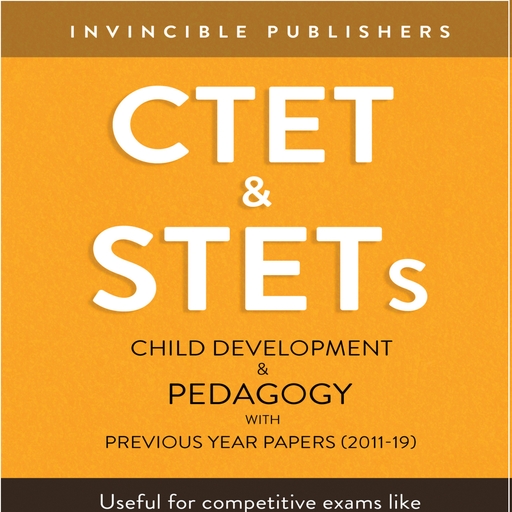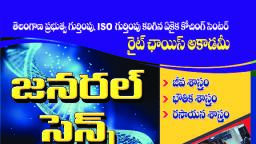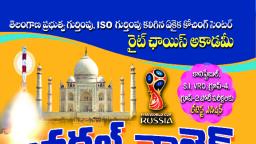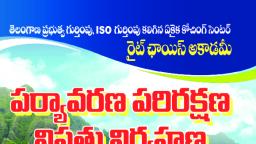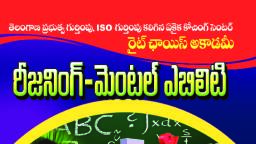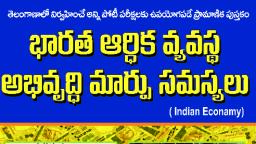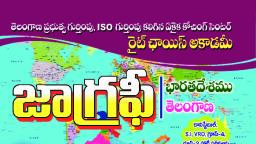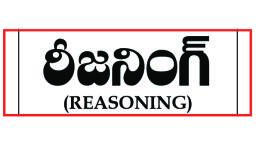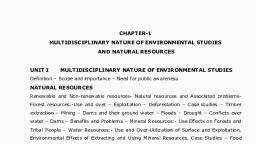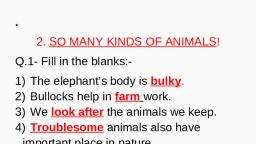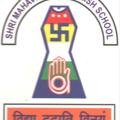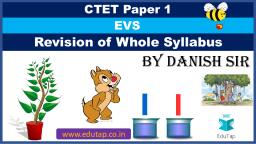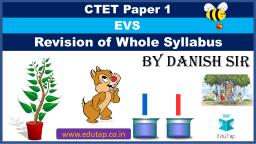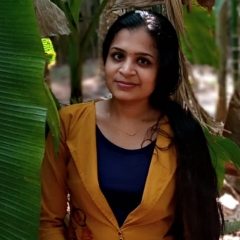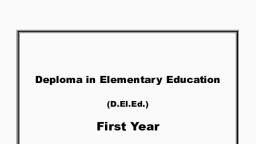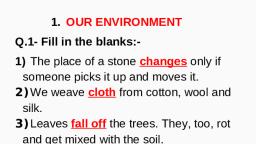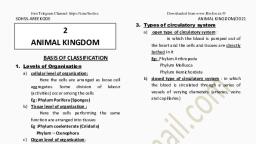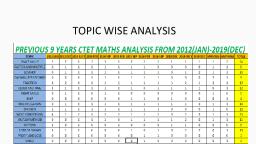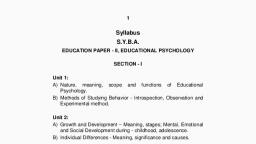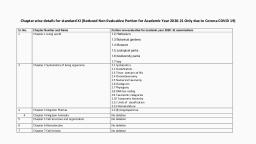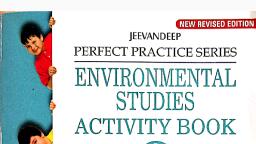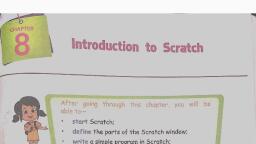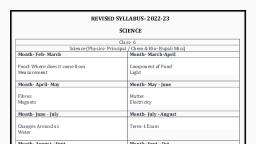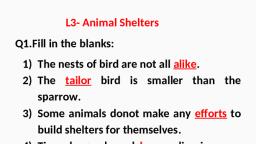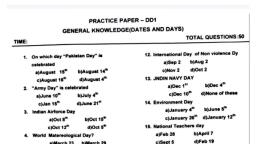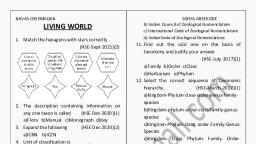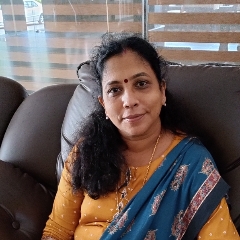Page 2 :
Whole Syllabus in Just 3 hrs., Sr. No., 1, 2, 3, 4, 5, 6, 7, 8, 9, 10, 11, 12, , Topic, Family and Friends, Plants, Animals, Food and nutrition, Health and Disease, Water, Shelter, Travel, Basics of Chemistry, Tradition, Culture and Languages, State, Cities and Capital, Miscellaneous
Page 3 :
Today’s Session, Information, , Questions, Concept Clarity, , PDF, , Telegram No. : 8146207241
Page 4 :
Family, , •, , Family is the basic unit of society., , •, , Family is a group consisting of parents, with or without children, and relatives., , •, , Family makes personal, emotional, intellectual, and social, development.
Page 5 :
Types of Family, 1., , Nuclear Family, , 2., , Joint or Extended Family, , 3., , Matriarchal Family, , 4., , Patriarchal Family, , 5., , Consanguineous Family
Page 6 :
1. Nuclear Family, • Nuclear families consist of father, mother and their unmarried, children., • It is also known as elementary or traditional families or conjugal, family., , 2. Joint Family, • 3 or more generations., , • Grandparents, parents, siblings, uncles, aunts and, cousins living in one home.
Page 7 :
3. Matriarchal Family, • It is known as mother centered or mother dominated family., • The mother or the woman is the head of the family., • After the marriage the wife stays back in her mother's home., , 2. Patriarchal Family, • It is known as father centered or father dominated family., • The father is the head of the family and exercises, , authority., • Patriarchal family is patrilocal in residence i.e. son continue to, live with the father after their marriage.
Page 8 :
5. Consanguineous Family, • Consanguineous means “of same blood”., • It means in this kind of family individual who have descended from the same ancestor, lives together.
Page 9 :
Previous Year Question, , Sept. 2016, , By Danish sir
Page 10 :
Plants
Page 11 :
Year, , July 2013, Feb 2014, Sept 2014, Feb 2015, , No. Questions, 4, 1, 1, 2, 1, 2, 1, , Marks, 4, 1, 1, 2, 1, 2, 1, , Sept 2015, Feb 2016, Sept 2016, , 3, 1, 2, , 3, 1, 2, , June 2011, Nov 2012, June 2013
Page 12 :
Plants, •, , Plants are multicellular living organism., , •, , They belong to the kingdom Plantae., , •, , They can live on land and in water., , •, , Food we eat comes from plants example fruits, vegetables, cereals, pulses etc., , •, , They provide us wood, paper, medicines, etc.
Page 14 :
1. Root System (जड़ तंत्र), •, , Root is the underground part of the plants body., , •, , It grows towards the force of gravity., , •, , It fixes the plant within the soil and absorbs water and mineral nutrients, from the soil., , •, , It stores excess food., , •, , Plants have following two types of roots:, • Tap Roots, • Fibrous roots
Page 15 :
Functions of Roots, • A root holds a plant erect and in one place., • Roots hold a plant firmly to the soil., • Roots absorb water and minerals from the soil and pass them to, the plant., • Some roots store food for the plant., • Roots of plants like carrot, Sweet Potatoes, radish and beetroot, store food. These can be eaten.
Page 17 :
Previous Year Question, , Feb. 2016, , By Danish sir
Page 18 :
2. Shoot System, •, , The part of the plant above the soil is known as the shoot., , •, , It is composed of stems on which are attached leaves,, flowers, branches, fruits and buds.
Page 19 :
Leaf, •, , Green leaves prepare food for plant through the process of photosynthesis., , •, , Large number of minute openings present on the leaves are called stomata., , •, , Gaseous exchange takes place between the atmosphere and the plant body., , •, , Non-green plants such as mushroom do not prepare their food., , •, , Leaves of many plants are eaten as food such as spinach, lettuce, cabbage etc.
Page 20 :
Functions of Leaves, 1. Photosynthesis, • The process of producing food, known as photosynthesis., • It occurs in the leaves., • Sunlight is absorbed by Chlorophyll Pigment., • Carbon Dioxide is absorbed by Stomata., , • Water is taken from roots., , By Danish sir
Page 21 :
Functions of Leaves, 2. Transpiration, • Plants lose a large volume of water through the leaves in the form of vapor., • The exit of water is through the stomata., • The stomata are usually open during the day, and close at night., • Transpiration pull is responsible for the continuous ascent, of water and nutrients from the roots to parts of trees.
Page 24 :
IV. Flower and Fruit, • Flowers are the most attractive part of a plant, • Smell of flower attract insects and bees to pollinate the flower., , • Flowers that we eat are broccoli and cauliflower., • Buds grows into flower and flower becomes fruit enclosing the seed or seeds., •, •, •, •, , One seed : Mango and Cherry, etc., Few seeds : Apple, Oranges, etc, Many Seeds : Papaya, watermelon, etc, Banana has no seeds.
Page 27 :
Significance of Plants, • Earth is called a green planet due to the presence of plant., • Plants help in maintaining gaseous balance in the air through, photosynthesis., • They consume CO2 emitted by animals and produce oxygen., • Plants provide oils obtained by crushing of the seeds., • Ex. mustard oil, groundnut oil, coconut oil, sunflower oil etc, • Plants have medicinal value like Tulsi, neem, garlic, aloevera, etc., , By Danish sir
Page 28 :
Significance of Plants
Page 29 :
Feb. 2014
Page 30 :
Special Plants and their features, I. Desert Oak, • It is found in the dry desert region of the Australia., • The depth of these roots is nearly 30 times the height of the tree., • It has very few leaves and has long segmented branches., • It grows almost as tall as 10 to 15 feet., , • Roots go deep into the ground till they reach water and it is stored in, the tree trunk. The local people use to put a thin pipe into the, trunk of the tree, to drink this water.
Page 31 :
Feb. 2014
Page 32 :
Q. Which one of the following is not a characteristic features of the roots of a, , Banyan tree? (CTET Sept 2015), (1)Roots hang down from the branches, , (2)It has life span of over 2000 years., (3)Its leaf, bark, seeds has medicinal values, (4)Root provides support to trees like pillars
Page 33 :
V., , Banyan Tree, , • It has life span of over 200 years., • Hanging branches of old banyan trees are actually the roots of the, tree., • These grow down from the branches until they reach the ground., , • These roots are like pillars that provide strong support to the tree., • Its leaf, bark, seeds has medicinal values to treat diseases like, diarrhea, dental, diabetes and urine disorders., , By Danish sir
Page 34 :
Q. Which one of the following is not a characteristic features of the roots of a, , Banyan tree? (CTET Sept 2015), (1)Roots hang down from the branches, , (2)It has life span of over 2000 years., (3)Its leaf, bark, seeds has medicinal values, (4)Root provides support to trees like pillars
Page 35 :
III. Khejri Tree, • Khejadi or Khejri trees is found in Rajasthan., , • Its fruits are eaten as a rich protein source, bark of the tree is used as, medicine., • Insects cannot harm its wood., , IV. Banana, • The banana stem is actually the flower stalk of the banana plant., • It is a 'herb’., • Its flower and fruit both are edible.
Page 36 :
II. Nepenthes / Pitcher Plant, • It is a carnivorous and insectivorous plants, • It traps insects, frogs and mice in its pitfall trap., • Pitcher is a modification of leaf., • It produce good smell to attract insects., • It is found in Indonesia, Australia and Meghalaya of India., • Plant is able to do photosynthesis due to presence of chlorophyll., • It eat insects to overcome deficiency of nitrogen.
Page 38 :
Previous Year Question, , Nov. 2012, , By Danish sir
Page 39 :
Animals
Page 40 :
Year, , No. Questions, , Marks, , June 2011, , 1, , 1, , Jan 2012, , 2, , 2, , May 2012, , 1, , 1, , Nov 2012, , 2, , 2, , July 2013, , 3, , 3, , Feb 2014, , 5, , 5, , Sept 2014, , 3, , 3, , Feb 2015, , 4, , 4, , Sept 2015, , 2, , 2, , Feb 2016, , 1, , 1, , Sept 2016, , 2, , 2
Page 41 :
Animals, •, , Animals are important part of nature., , •, , Animals are also found all over the world., , •, , From deepest oceans and on the highest mountains, , •, , They can live on land and in water., , •, , They differ in sizes, shapes, color, , •, , They need food, water, and shelter to live
Page 42 :
Animals, •, , Animals are grouped into 6, groups depending on how they, are alike and different.
Page 44 :
Classification of animals, 1. Based on Body Structure, VERTEBRATES (कशेरुकी जानवर), • Vertebrates are animals that have a backbone., • They have a firm body because of the muscles that connect to, their skeleton., • Animals like, amphibians., , Mammals,, , birds,, , fishes,, , reptiles, , and
Page 45 :
Classification of animals, 1. Based on Body Structure, INVERTEBRATES (अकशेरुकी जानवर ), • Invertebrates are animals that do not have a, backbone., • They have soft inner bodies which are held in shape, by a flexible covering of outer cells or by a hard, covering called an exoskeleton., , • Example Insects,, mosquito, etc., , crabs,, , snails,, , starfish,
Page 47 :
Classification of animals, 2. Based on Nutrition, Autotrophs (स्वपोषित), • Autotrophic organisms are called "producers" ., • They create their own food by the, photosynthesis., , process, , of, , Heterotrophs (परपोषित), , • Heterotrophs are those organisms that cannot produce their, own food but depend upon plants and other organisms to, survive., • They are called as consumers.
Page 48 :
Classification of animals, 3. Based on Adaptation in animals, • The surroundings, or the environment in which an animal or a, plant lives, is called its habitat., • Earth has many habitats., • There are cold mountains, wet and thick rain forest, hot and, dry deserts, rivers and salty oceans, open grasslands., • According to their habitat’s animals can be classified into four, types. i.e.,, i. Terrestrial animals (स्थलीय जानवर), ii. Aquatic animals (जलीय जानवर), iii. Amphibians (उभयचर जानवर), iv. Arboreal (वक्ष, ृ ीय जानवर)
Page 49 :
Classification of animals, 3. Based on Adaptation in animals, 1., , Terrestrial animals or land animals (स्थलीय जानवर), , • Animals that live primarily on land is called land animal or terrestrial animals., • Terrestrial habitat types include forests, grasslands, wetlands, and deserts., • Example peacock, horse, rhinoceros, elephant, giraffe, buffalo, cat, dog,, deer, etc.
Page 50 :
Classification of animals, 3. Based on Adaptation in animals, 2., , Aquatic animals or Water animals (जलीय जानवर), , • Animals that lives in water are called water animal., • They have specialized organs called gills, or directly through its skin to breathe in, water., • Example includes whale, shark, dolphin, seahorse, octopus, fish etc.
Page 51 :
Classification of animals, 3. Based on Adaptation in animals, 3. Amphibians (उभयचर जानवर), • Animals which can live on both land and in water., , • They have moist, slimy and soft skin., • They mainly live in moist places or close to water to keep their, body from drying., • E.g. frogs, toads, salamanders, newts, etc, , By Danish sir
Page 52 :
Classification of animals, 3. Based on Adaptation in animals, 4. Arboreal Animals (वक्ष, ृ ीय जानवर), • Animals who live primarily on trees., , • They eat, sleep and play in tree canopy., • Example: Squirrel, chameleon, monkey, rodents, parrots, etc.
Page 53 :
Classification of animals, 4. Based on Body Temperature, 1., , Cold Blooded animals शीतरक्ती जानवर, , • Cold blooded animals are those animals which change their, body temperature according to the changes in the environment., • For examples: Fishes, frogs, reptiles, insects, amphibians,, etc., 2. Warm Blooded animals गर्मरक्ती जानवर।, • The body temperature of warm-blooded animals is constant i.e., it does not change according to their surroundings., • For example: Humans, mammals, birds, etc., , By Danish sir
Page 54 :
Classification of animals, 5. Based on Food Habits, Plant-eating animals (Herbivorous (शाकाहारी) animals):, • Some animals feed on grass, plants, fruits and roots., , • These are plant-eating animals and are called Herbivores., •, , They do not eat the flesh of other animals., , • Examples: cows, horses, goats, elephants, etc.
Page 55 :
Classification of animals, 5. Based on Food Habits, Flesh-eating animals (Carnivorous animals : मांसाहारी जानवर):, • Some animals eat other animals., • These are flesh-eating animals and are called carnivores., • They do not eat plants., • Examples lions, tigers, snakes, wolves, etc.
Page 56 :
Classification of animals, 5. Based on Food Habits, Plant and flesh-eating animals (Omnivorous (सवामहारी) animals):, • Some animals eat both plants as well as the flesh of other, animals., • These animals are called omnivores., • Example bears, jackals, cats, dogs, etc. animals eat other, animals., , • Humans also eat meat, fish, eggs as well as vegetables,, fruits and nuts. So, they are also omnivores., Note: Monkeys are omnivores by nature. They eat a wide variety of, food from flowers, leaves and fruits to insects and small frogs.
Page 57 :
Classification of animals, 5. Based on Food Habits, Decomposers: जैव अपघटक, • Decomposers are organisms that help to break down dead or, decaying organisms., • Decomposers are heterotrophic., • Ex. Fungus, worms, insects, etc.
Page 59 :
Reproduction in animals, • Reproduction is a process by which living organism produce another one of their own kind., • It is vital process for every animal to continue its race., • There are two ways for reproduction:, • By laying eggs, • By giving birth to young ones
Page 60 :
Reproduction in animals, 1. Animal That Lay Eggs (प्राणी जो अंडे दे ते है ), • Some animals reproduce by laying eggs., • Example insects, fish, frogs, snakes, lizards, snails, birds, and crocodiles., • Bird builds nest to lay eggs., • Insects such as butterflies, grasshoppers, cockroaches, and houseflies lay eggs., • Reptiles (सरीसप, ृ ) (रें गने वाले प्राणी) such as Lizards, turtle and, snakes also lay eggs., • Most of their eggs are eaten by other animals.
Page 65 :
Reproduction in animals, जानवर जो बच्चे को जन्र् दे ते हैं, , 2. Animals that give birth to young ones, • Some animal give birth to young ones., • Such animal is called mammals (स्तनधारी)., • Example dogs, cats, monkeys, tigers, cows, elephants,, horses and humans., • The baby develops inside the mother’s body., , • After their birth they feed on mother’s milk till they learn to feed, by their own., • Whales and Dolphins lives in water but they give birth to young, ones., , • Bat though a bird give birth to young ones.
Page 68 :
Sense organs in animals, 1. Birds, • There are 5 senses in animals on the Earth. These are, , eyes, ears, nose, tongue and skin., • Some special birds like kites, eagles and vultures can, see things four times more than humans so that they, can recognize their prey from the distance., • Nocturnal animals can only see white and black, color. e.g. owl, raccoon., • Bats are mammals because they give birth to their, young ones., , By Danish sir
Page 69 :
Sense organs in animals, 1. Birds, • There are 5 senses in animals on the Earth. These are eyes,, , ears, nose, tongue and skin., • Some special birds like kites, eagles and vultures can see, things four times more than humans so that they can, recognize their prey from the distance., , • Birds can see at different direction at a time because they, have eyes on the left and right of the face., • Nocturnal animals can only see white and black color. e.g., owl, raccoon., • Bats are mammals because they give birth to their young, ones., , By Danish sir
Page 70 :
Special features of animals, Birds, • Ostrich and emu are non-flight animals, they run, instead of flying., • Bird’s eyes are fixed. Hence They rotate their neck very, often., • Owl can almost fully rotate their heads as it has fixed, eye sockets. i.e. their eyeballs cannot rotate.
Page 71 :
Previous Year Question, , Sept. 2014, , By Danish sir
Page 72 :
Previous Year Question, , Feb. 2014, , By Danish sir
Page 74 :
Previous Year Question, , Nov. 2012
Page 75 :
Special features of animals, Birds, • Egret Bird (बगल, ु ा) and buffalo have, symbiotic relationship, (सहजीवी संबंध)., , • Egret bird is often seen on a buffalo’s, back as it feeds on parasites on, buffalo’s back.
Page 76 :
Previous Year Question, , www.edutap.co.in, , Sept. 2016, , By Danish sir
Page 77 :
Special features of animals, 5. Reptiles, • Reptiles such as snakes hears from the vibrations coming out, of a surface or land., • Snake do not have any external ear., • They can only feel vibration from the ground., • When snake bites, poison enters only through fangs (two, hollow teeth)., , • There are many kinds of snakes in our country, only four of, them are poisonous., • They are Cobra, Karait, Russel's viper (Duboiya) and SawScale Viper (Afai)., , • Medicine of snake bites is made from snake’s poison.
Page 78 :
Previous Year Question, , Sept. 2016
Page 79 :
Honey bees, • Honey bees are attracted to litchi flower., • Honeybee lay their eggs from October to December., , • So, it is the best time to start bee-keeping., • Every bee-hive has one queen bee that lay eggs., • Most of the bee in the hive are worker-bees., • They collect nectar from flowers for honey., • The male bees have no special role as worker., , By Danish sir
Page 80 :
Previous Year Question, , Nov. 2012, , By Danish sir
Page 81 :
Feb. 2014
Page 82 :
Special Characters of Animals, Elephant, • Elephants are herbivorous, elephants large ear flaps help to control their body, temperature., • Leader of group is often the oldest female elephant., • Male elephants live in the herd till they are 14–15 years old., • One elephant can eat 100 kilograms (1 quintal) of leaves and twigs in one day., • Elephants do not rest very much. They sleep for only 2 to 4 hours in a day., • Elephants love to play with mud and water. The mud keeps their skin cool., • Three months old baby elephant weighs 200 kilograms.
Page 83 :
Special Characters of Animals, Elephant, • Elephants are herbivorous, elephants large ear flaps help to control their body, temperature., , शाकाहारी, , • Leader of group is often the oldest female elephant., • Male elephants live in the herd till they are 14–15 years old., • One elephant can eat 100 kilograms (1 quintal) of leaves and twigs in one day., • Elephants do not rest very much. They sleep for only 2 to 4 hours in a day., • Elephants love to play with mud and water. The mud keeps their skin cool., • Three months old baby elephant weighs 200 kilograms.
Page 84 :
Feb. 2014
Page 85 :
Previous Year Question, , Sept. 2014
Page 86 :
Special Characters of Animals, Elephant, • Elephants are herbivorous, elephants large ear flaps help to control their body, temperature., • Leader of group is often the oldest female elephant., • Male elephants live in the herd till they are 14–15 years old., • One elephant can eat 100 kilograms (1 quintal) of leaves and twigs in one day., • Elephants do not rest very much. They sleep for only 2 to 4 hours in a day., • Elephants love to play with mud and water. The mud keeps their skin cool., • Three months old baby elephant weighs 200 kilograms.
Page 87 :
Previous Year Question, , Sept. 2014
Page 88 :
Special Characters of Animals, Tiger, • Tiger may consume up to 40 kg of meat at one time., , • It has six times more sight capacity than humans in night., • For hearing they can move their ears in different direction., • Tiger can make difference between rustling of leaves and, sound of animal moving on the grass.
Page 89 :
Special Characters of Animals, Sloth, • Sloth are mammals which looks like beer., • It is a nocturnal animal, sleeps around 17 hours in day time by hanging upside down on tree., • The sloth eats the leaves of the same tree on which it lives., , • Sloths live for about 40 years and in that time, they move around, only eight trees.
Page 90 :
Special Characters of Animals, Giraffe, • Giraffe is the tallest mammal of the Earth, it has about 5-meter height., , • It sleeps for very less time (around 2 hours in 24 hours)., • Its life time is about 25 years.
Page 91 :
Birds and their Living, • Bulbul uses bushes with dried grass to make nest., • Robin nest is made up of soft twigs (मुलायम टहननयााँ), roots,, wool, hair, cotton wool and grass., • Robin's nest is very soft in nature., • Crow (कौआ) make its nest using wire, wood, grass and twigs, and it makes nest high up on trees (पेड़ की ऊाँची डाल पर).
Page 92 :
Birds and their Living, • Koel or Cuckoo does not make its, own nest., , Koel, , • It lays its eggs in a crow’s (कौआ) nest., , • The crow hatches them along with its own eggs., • The Dove makes its nest among the thorns of a, cactus plant., , Koel egg in crow’s nest
Page 93 :
Birds and their Living, • Koel or Cuckoo does not make its, own nest., , Koel, , • It lays its eggs in a crow’s (कौआ) nest., , • The crow hatches them along with its own eggs., • The Dove makes its nest among the thorns of a, cactus plant., , Koel egg in crow’s nest
Page 96 :
Year, , No. Questions, , Marks, , June 2011, , 5, , 5, , Jan 2012, , 3, , 3, , July 2013, , 2, , 2, , Feb 2014, , 1, , 1, , Sept 2014, , 3, , 3, , Feb 2015, , 2, , 2, , Sept 2015, , 2, , 2, , Feb 2016, , 2, , 2
Page 97 :
Different components of food, 1., , Carbohydrate, , 2., , Fats, , 3., , Proteins, , 4., , Minerals, , 5., , Vitamins, , 6., , Roughage and water
Page 98 :
Carbohydrates, • Carbohydrates provide energy for the body., • Children and people who do physical labor need lots of carbohydrates., • Cereals such as rice, wheat and maize are rich in carbohydrates., • Sugar and things containing sugar as well as potatoes, beans, bananas., • Fruits (apples, banana and grapes), vegetables (potato and pumpkin),, milk, milk products,
Page 99 :
Fats, • Fats also provide energy for the body., • They act as reserve of energy when carbohydrates are not available., • It helps to keep body warm., • Food rich in fats include oil, butter, nuts, coconut, ghee, cheese, cream etc.
Page 100 :
Fats, • Proteins are nutrients that help our body to grow., • Our worn-out tissues of the body are also needed to repair by proteins., • They are called the body-building nutrients., •, , Protein rich foods are pulses, milk, milk-preparations (such as cheese,, ghee, yogurt, etc.), nuts, seeds, beans, groundnut, eggs, fish, meat, etc., , • Note: Weightlifters require more protein to make muscles and increase, , body mass.
Page 103 :
Vitamins, • Vitamin helps to form and maintain healthy teeth, bones and skin., • Vitamins are required in small quantities to prevent deficiency diseases., •, , It helps to fight against infection and diseases., , • Ex. broccoli, papaya, almonds, sunflower oil, spinach, carrot, pumpkin,, orange, beans etc., • All citrus fruits contain a lot of vitamin ‘c’ that help to fight against infections.
Page 104 :
Vitamins and its sources
Page 105 :
Minerals, • Body needs many minerals such as calcium, iron, iodine,, potassium, etc., , • We need all minerals in to stay healthy in desired quantity., • Our body needs calcium to maintain healthy bones and, teeth., • Calcium we get from milk, milk products etc., • Iron is also a mineral which helps in the formation of blood., • Iron rich food includes red meats, dried fruits, green leafy, vegetables.
Page 106 :
Minerals and its sources
Page 107 :
Previous Year Question, , Sept. 2016, , By Danish sir
Page 108 :
Previous Year Question, , July 2013
Page 109 :
Previous Year Question, , Sept. 2014
Page 112 :
Previous Year Question, , Sept. 2014
Page 114 :
Year, , No. Questions, , Marks, , Feb 2011, , 2, , 2, , June 2011, , 5, , 5, , Jan 2012, , 4, , 4, , Nov 2012, , 1, , 1, , July 2013, , 2, , 2, , Feb 2015, , 1, , 1, , Sept 2015, , 1, , 1, , Feb 2016, , 2, , 2, , Sept 2016, , 1, , 1
Page 115 :
Disease due to stagnant water, • Stagnant water is water that sits in a single place of your home such, as water pots, coolers, tanks, etc., • Stagnant water attract insects ,rodents, mosquitos, etc., • Mosquitoes commonly breed in standing water and lay eggs., • Standing water is the perfect environment for breeding and for the, larvae to grow., • Larvae need non-moving water rich with microorganisms to eat., • Mosquitoes carry diseases like Malaria, Dengue, Chikungunya,, Japnese Encephalitis, etc.
Page 116 :
Disease caused by mosquitoes
Page 117 :
Previous Year Question, , Feb 2015
Page 118 :
Note: Most commonly used drug in fever is paracetamol
Page 121 :
Steps to control, • Water should not be allowed to collect near the house., •, , Keep the water pots, coolers, tanks clean and dry them every week., , • Use a mosquito net in areas with stagnant water sources such as lakes, or non-running streams., • Spraying insecticides or oil in and around the house., • Spray kerosene if water has collected.
Page 122 :
Malaria, • Malaria is typically transmitted through the bite of an infected, Female Anopheles mosquito., • Infected mosquitoes carry the Plasmodium parasite in there, salivary gland., • These germs grow in the body of mosquito in 7 to 10 days., • Infected person passes through a cycle of shivering, fever and, headache and finally sweating., • The dried and powdered bark of the Cinchona tree is used to make, , a medicine for malaria., • Medicine used for treating malaria is generally bitter in taste
Page 123 :
Q., , Rajat said to his friend, "I cannot play because, I am down with fever. I pass through a cycle of, , shivering, fever and headache and finally sweating. After my blood test doctor prescribed me a bitter, medicine". Rajat might be suffering from, (1) typhoid, (2) diarrhoea, (3) cholera, , (4) malaria
Page 126 :
Deficiency Disease, • Diseases caused due to inadequate intake of an, , essential nutrient in the diet are called deficiency, diseases., • These are non-infectious or non-transmissible i.e., these are not passed on from one person to another., • Example: scurvy (lack of vitamin C), rickets (lack of, vitamin D), and anaemia (iron-deficiency).
Page 127 :
Deficiency Disease, Vitamin Deficiency, • Vitamins are required in very small amount so called as micronutrient., •, , Main function of vitamins is to Protect our body against diseases., , • Vitamins help in keeping our body parts like eyes, bones, teeth and, gums healthy.
Page 129 :
Deficiency Disease, Minerals Deficiency, • Minerals are inorganic substances presents in our food., • They do not provide energy, but they are required for growth,, repair and regulation of important body function.
Page 132 :
Home remedies of some disease
Page 133 :
Taste buds, • Taste buds are present on our tongue., , 1.Bitter, , 2. Sour, 3. Salt, 4. Sweet
Page 134 :
1.Bitter, 2. Sour, 3. Salt, 4. Sweet
Page 135 :
1.Bitter, 2. Sour, 3. Salt, 4. Sweet
Page 136 :
Digestive System, • All living things eat food for energy., , • Food we eat is broken into small pieces for the body to absorb., • The nutrients from food are absorbed in the body and used for, energy., , • The process of breaking down of food into smaller particles that, can be absorbed by our bodies is called digestion., • The organs involved in the process of digestion are mouth, food, pipe (esophagus), stomach, small intestine, liver, pancreas,, large intestine and anus.
Page 137 :
Digestive System, Mouth, • Digestion starts with mouth., , • Teeth help to chew and grind the food into simpler particles., • Salivary gland secretes saliva that helps to soften the food and, helps in further breaking down of food., , Tongue, • Tongue is a muscular organ that helps in mixing of saliva with, food which makes swallowing of food easy., , • Tongue contains taste buds such as sweet, sour, salty and, bitter.
Page 138 :
Digestive System, Food Pipe, • Food Pipe is a muscular tube from the mouth to the stomach., • When we swallow, food goes down the food pipe and reaches, our stomach., , Stomach, • The stomach is a sac-like organ with strong muscular walls., • It can store food for several hours., • In the stomach gastric juices secreted by stomach, breakdown the food further into paste., • The Gastric juice in stomach is acidic in nature., • From stomach food moves to small intestine.
Page 139 :
Digestive System, Small Intestine, • The small intestine is a tube that is about 18 feet long., • In the small intestine, food mixes with juice secreted by Stomach., • Here food is changed into fine particles and absorbed through, the walls of small intestine and finally into the blood., • Most of the nutrients from the food are absorbed in the small, , intestine.
Page 140 :
Digestive System, Large Intestine, • From small intestine undigested food passes to large, intestine., • It is 5 – 7 feet long., • Water is absorbed here., • The undigested food passes through the large, intestine and sent out from anus.
Page 141 :
Water
Page 142 :
Year, , No. Questions, , Marks, , Jan 2012, , 5, , 5, , Nov 2012, , 1, , 1, , Feb 2014, , 1, , 1, , Sept 2015, , 1, , 1, , Feb 2016, , 2, , 2
Page 143 :
Water, • Water in our life plays an important role., • It is very essential for all living things like human, beings, animals and plants., • Our body contains 70% water by weight., , • We need to drink about 3 liters of water daily., • Water is used in digesting food and circulating, various nutrients in the body.
Page 144 :
Sources of water, • Earth is called as 'BLUE PLANET' because of abundance of water, , of Earth., • About 71% of Earth's surface is covered by water, which produce, a blue color reflection when viewed from space., • 97% of Earth's water is present in oceans., • Water also exists in air as water vapor, in rivers and lakes, in, icecaps and glaciers., • Only 3% water present on Earth is fresh water.
Page 145 :
Properties of water, • Pure water is transparent, colorless, odorless and tasteless., , • Water takes up the color, odor and taste of the substance that, dissolves in it., • Water has no definite shape., • The temperature at which a liquid boil and turns to vapor is called, its boiling point 100°C is the boiling point of water.
Page 146 :
Properties of water, • Things that have density more than water will sink in water and, things that have lesser density than water will float on the water., • E.g. wooden boat, iron ship, empty plastic bottle, empty bowl,, ice and soap with soap case will float in water., , • Whereas bowl filled with pebbles, iron, nail, needle, spoon,, bottle full of water, soap cake etc. will sink in a water.
Page 147 :
Properties of water, • Lemon and egg when placed in pure water will sink in water, but, when same lemon and egg are placed in water in which good, , amount of salt is present will float in water., • The thing which will be heavier than water will sink and thing, which will be lighter will float on the water surface.
Page 148 :
Do You Know?, ➢ All ocean and sea have salty water., ➢ The saltiest of all is the dead sea., ➢ Approximately 300 grams of salt is present in one liter of water., ➢ Even if a person who does not know how to swim will not drown in, this sea, person will float as if lying down on it.
Page 149 :
Feb. 2014
Page 150 :
Why water is necessary for our body?, • Almost two-thirds (70%) of our body weight consists of water., • Water has no food value. But it is one of the most important, components of our food., • We need a lot of water to digest the food, get rid of waste and use, the nutrients properly., , • The waste and soluble materials go out of the body due to water as, urine.
Page 151 :
Why water is necessary for our body?, • Our body also needs sufficient amount of water to stay healthy., , • Our blood contains water., • Our muscles also contain some water., • Our body needs about 3 to 4 liters of water every day i.e. 8 glasses, of water a day., • Many fruits such as cucumber, melons, etc. contain a large amount, of water., • We take water in the form of cold-drink, coffee, tea, etc.
Page 152 :
Uses of water, • Water plays very important role in digestion of the body., , • it facilitates the absorption of nutrients in the blood and then their, distribution to various body parts., • Water helps in maintaining body temperature by sweating., • Water is essential for the germination of seeds and growth of, plants., • Water helps in transportation of nutrient and mineral in plants.
Page 153 :
• NOTE: Alum (phitkari) is used to settle, down light suspended impurities in water, and make it clean for drinking purpose., , ✓, , Concept Check, Q. Rekha's mother adds Phitkari (Alum) to water collected from the pond every day in order to, (CTET Jan 2012), (1) sediment light suspended impurities, , (2) change hard water into soft water, , (3) kill germs in water, , (4) decolorize water, , Answer: (1)
Page 154 :
• NOTE: Alum (phitkari) is used to settle, down light suspended impurities in water, and make it clean for drinking purpose., , ✓, , Concept Check, Q. Rekha's mother adds Phitkari (Alum) to water collected from the pond every day in order to, (CTET Jan 2012), (1) sediment light suspended impurities, , (2) change hard water into soft water, , (3) kill germs in water, , (4) decolorize water, , Answer: (1)
Page 156 :
Previous Year Question, , Nov. 2012, , By Danish sir
Page 157 :
Diseases due to water, • Diseases due to impure water like hepatitis, jaundice, diarrhea, etc., • Water provides the breeding place mosquitoes and these mosquitoes can, cause malaria, dengue and chikungunya.
Page 158 :
Previous Year Question, , Nov. 2012
Page 159 :
Shelter
Page 160 :
Year, , No. Questions, , Marks, , June 2011, , 1, , 1, , Jan 2012, , 1, , 1, , Nov 2012, , 1, , 1, , Sept 2014, , 1, , 1, , Sept 2015, , 2, , 2, , Feb 2016, , 1, , 1
Page 161 :
Houses according to type of region, Houses Made up of Mud/ Thatched House, • These houses are found in hot deserts of Rajasthan and in villages., • In deserts of Rajasthan, these houses help in better adapting to, excessive heat, mud wall of these houses are made thick so that heat, , does not cross it., • Roofs are made up of fodder and bushes, wood of acacia (kikar) is, used in roof in order to protect roof from insects., • These houses are painted with mud and cow dung to protect the, mud from breaking and for protection against the insects.
Page 162 :
Previous Year Question, , May 2016
Page 163 :
Previous Year Question, , June 2011, , ✓ Concept Check, Q. In rural areas, cow dung is used to coat the floor and walls of huts to (CTET June 2011), (1) give a natural color to the floor, , (2) keep the insects away, , (3) make them smooth and clean, , (4) make them rough to increase friction, , Answer: (2)
Page 164 :
Houses according to type of region, , House Made up of Wood and Bamboo, • These houses are made in those areas where there is very heavy rain., • These bamboo and wood houses are 3 m to 3.5 m (10 to 12 feet) above, , the ground, so that it remains unaffected from flood., • These houses are found in Assam and in some other parts of NorthEast.
Page 165 :
Previous Year Question, , Sept. 2014
Page 166 :
Previous Year Question, , Feb. 2016
Page 167 :
Houses according to type of region, House Made up of Stone, • Stone houses are found in cold desert of Ladakh (J & K) and, other hilly desert areas., • House are of two floors., • The houses are made of stones which are kept one over the, other., • The walls are coated with a thick layer of mud and lime., , • Thick tree trunk may be used to make roof of first floor strong and, wooden floor, wooden ceiling is also found in the houses.
Page 168 :
Houses according to type of region, House Made up of Stone, • In two floored building of Ladakh, on the ground floor, necessary things and animals are kept and, • On the first-floor people live., • Ground floor do not have windows., • In intense cold people can shift to the ground floor., • Vegetables and fruits are kept for drying on the roof of house.
Page 170 :
Houses according to type of region, House Made up of Stone, • Stone houses are found in cold desert of Ladakh (J & K) and, other hilly desert areas., • House are of two floors., • The houses are made of stones which are kept one over the, other., • The walls are coated with a thick layer of mud and lime., , • Thick tree trunk may be used to make roof of first floor strong and, wooden floor, wooden ceiling is also found in the houses.
Page 171 :
Houses according to type of region, House Made up of Stone, • In two floored building of Ladakh, on the ground floor, necessary things and animals are kept and, • On the first-floor people live., • Ground floor do not have windows., • In intense cold people can shift to the ground floor., • Vegetables and fruits are kept for drying on the roof of house.
Page 172 :
Previous Year Question, , Nov. 2012
Page 174 :
Houses according to type of region, House Made up of Stone and Wood, • These houses are found in hilly areas where there is good amount of, rainfall and snowfall., • Roof of these houses are sloping on the sides so that snow and rain, , can fall easily on the ground. These houses may be made up of stone,, bricks and woods., • These houses can be found in Srinagar, Manali and other areas of, Kashmir valley.
Page 175 :
Houses according to type of region, House Made up of Stone and Wood, • Houses in Srinagar display beautiful carving of wood on the ceiling of, house, door and windows have beautiful arches known as Mehraab., , • A special window made up of wood called dab, can be found in the old, houses of Srinagar., • In villages of Kashmir, houses are made from stone cut and kept one, , on top of other and coated with mud. These houses also have, sloping roof.
Page 176 :
Houses according to type of region, House Boat, • House boat are made up of wood and are present in water. These, houses can be up to 80 feet long and 8-9 feet wide., • These house boats have beautiful wooden carving on it and these, carving are known as Khatamband., • These house boats are found in Kashmir and Kerala.
Page 177 :
Houses according to type of region, Donga, • Donga are house in water, house is present on the boat, with different, rooms in it., • It can be seen in Dal lake Kashmir.
Page 178 :
Previous Year Question, , Sept. 2016
Page 179 :
Houses according to type of region, Igloo, • Igloo are found in very cold region. These houses are made up of ice, blocks., , • Shape of Igloo is oval shaped and entry door of Igloo is very small., • Eskimos live in the Igloo., • Snow is used because the air pockets trapped in it make it an, , insulator., • Animal skins and furs used as floor flaps to keep warm air in.
Page 180 :
Travel
Page 181 :
Year, , No. Questions, , Marks, , June 2011, , 3, , 3, , Jan 2012, , 1, , 1, , Nov 2012, , 3, , 3, , July 2013, , 1, , 1, , Feb 2014, , 3, , 3, , Sept 2014, , 2, , 2, , Feb 2015, , 4, , 4, , Sept 2015, , 2, , 2, , Total, , 19, , 19
Page 182 :
Land Transport, RAILWAY TICKET and TIME TABLE, • Ticket for travelling by any means of public transport i.e. railways,, roadways, airways and waterways, one needs to take a ticket., • Railway Tickets are of two types, , (i) Reserved, (ii) Unreserved
Page 183 :
Land Transport, RAILWAY TICKET and TIME TABLE, •, , RESERVED TICKET, , •, , This variety of ticket contains all relevant details about number of, passengers, passenger seat or berth, age, sex, name may or may not, be given on ticket, his boarding and destination point., , •, , It also carries detail about medium of transport being used i.e. train, number, arrival and departure time, etc. (Date and time of arrival at the, , destination is not mentioned), •, , Date of journey, date of reservation or booking, class of seat or, coach(Sleeper, 3AC, 2AC, first class) in railways, (economy or, business class) in plane etc., , •, , Total fare of journey is also denoted on the ticket.
Page 184 :
Previous Year Question, , Feb. 2014
Page 185 :
Land Transport, RAILWAY TICKET and TIME TABLE, , •, , UNRESERVED TICKET, , • This kind of ticket does not have full detail about journey., • Very minute details like boarding and destination point, date of, journey, fare of journey etc. are written on it only., • (No Name, no seat number)
Page 186 :
Let us know, What is Time, Distance and Speed?, •, , Time: Time can be defined as a period in which any vehicle or means of, transport cover any distance., , •, , Distance: It is a length covered by any means of transportation in a, given time., , •, , Speed: The rate at which something moves or travel. The relationship, between speed, distance and time is expressed as, , •, , Speed = Distance/Time, , •, , Average Speed = Total Distance/ Total Time, , •, , Time = Distance / Speed, , •, , Distance = Speed x Time
Page 187 :
Q. A train started from Gandhi dham on 16th July, 2014 at 05: 15 h and reached Nagercoil on 18th July, 2014, at 04: 45 h. The distance covered by the train is 2649 km. The average speed of the train, in km/h, is nearly., (CTET Sept 2014), , (1) 57, , Answer: (2), , (2) 56, , (3) 55, , (4) 54
Page 188 :
Q. A train started from Gandhi dham on 16th July, 2014 at 05: 15 h and reached Nagercoil on 18th July, 2014, at 04: 45 h. The distance covered by the train is 2649 km. The average speed of the train, in km/h, is nearly., (CTET Sept 2014), , (1) 57, , Answer: (2), , (2) 56, , (3) 55, , (4) 54
Page 189 :
Mountain Climbing, •, , Mount Everest is the highest mountain peak on the Earth. Its, peak is at 8,848 meter above the sea level., , •, , It belongs to the Nepal Himalaya., , •, , In Nepal, it is known as Sagarmatha and in Tibet is called, Chomolungma Himalaya., , •, , Bachhendri Pal became the first Indian woman and fifth woman in, the world to reach peak of Mount Everest., , Mt Everest, 8900 meters, Above sea level
Page 190 :
Previous Year Question, , Sept. 2014
Page 191 :
LET US KNOW ABOUT….!!, 1. Visit to Abu Dhabi, • Abu Dhabi is located in the desert, here water is very, precious., • There is no rain, no lakes, no rivers, no ponds and not, even a ground water but there is lot of oils below the, sands. Hence water is costlier than petrol., , • In Abu Dhabi, Dirham (Dinar) is used as, currency and local language on which most of, the people speak is Arabic., • Mountains of Sand are called ‘Sand Dunes’, • (रे त के टीले)
Page 192 :
LET US KNOW ABOUT….!!, 1. Visit to Abu Dhabi, , • Weather is so hot than people wear loose, cotton clothes and keep themselves fully, covered.
Page 193 :
Previous Year Question, , Feb. 2014
Page 195 :
LET US KNOW ABOUT….!!, 2. Visit to Golconda Fort and Museum, •, , Golconda fort is huge fort made up of thick walls and at some places, wall comes out in a round shape called bastion. Bastion were there to, ensure security of fort., , •, , Map of the fort showed many garden fields and factories. In fort not, only, king but many other people like farmers and workers also lived., , • Fort has 2 storey building, it had big halls and rooms with beautiful, carving on the wall, it had fountain on the roof and big water tank, , was also there.
Page 196 :
LET US KNOW ABOUT….!!, 2. Visit to Golconda Fort and Museum, •, , Fort had many cannons, which were used in the war, there were also, big guns and these guns were made up of bronze., , •, , At Fateh Darwaza in the fort sound echoed and if anyone speaks at, this place it can be heard at king’s palace.
Page 197 :
LET US KNOW ABOUT….!!, 2. Visit to Golconda Fort and Museum, •, , In museum, many old items are kept.
Page 198 :
Various sources of Energy and Fuels, •, , COAL, , • Coal is a non-renewable energy source because it takes millions, , of years to forms., • Carbon is its main constituent., • Coal is mainly used for formation of electricity, coal and coal tar., • West Bengal and Jharkhand are the main coal producing states, in India.
Page 199 :
Various sources of Energy and Fuels, •, , PETROLEUM, , • Petroleum is a fossil fuel., • That was formed from the remains of ancient marine organisms and, vegetations., • Petroleum is a thick, smelly, flammable, yellow-to-black colored, mixture of gaseous, liquid, and solid hydrocarbons that occurs, naturally beneath the Earth’s surface., • It is refined and separated by distillation process into gasoline, , (petrol), lubricants, diesel, kerosene oil and gas etc., • Mainly petroleum is used in automobile, paints and dry cleaning etc.
Page 201 :
Previous Year Question, , Nov. 2012
Page 203 :
CTET Paper 1 July 2019, , By Danish sir
Page 204 :
Previous Year Question, , By Danish sir, , Nov. 2012
Page 205 :
Famous Traveler, • From the ancient time, many travelers are coming to India and they have, provided very useful information about India of that period., • AL-BIRUNI, , • He came with Mahmud of Ghazni., • He belonged to Uzbekistan., • Al-Biruni carefully observed and noted down the details about India., • He has written Tahqiq-i-Hind and Kitab-ul-Hind., • He gave descriptive account about water bodies, river, ponds etc., , By Danish sir
Page 206 :
Previous Year Question, , By Danish sir, , Nov. 2012
Page 207 :
Previous Year Question, , Nov. 2012
Page 208 :
Famous Traveler, VASCO-DA-GAMA, • A Portuguese traveler came to India in 1498., , • He was the first European to reach India via the, Atlantic Ocean., • He came via the sea-route., • He landed at Calicut.
Page 209 :
Basics of Chemistry
Page 210 :
Year, , No. Questions, , Marks, , Nov 2012, , 1, , 1, , July 2013, , 1, , 1, , Sept 2014, , 1, , 1, , Sept 2015, , 1, , 1, , July 2019, , 1, , 1
Page 211 :
Alloys (, ✓ Alloys are mixture of two or more metals or a metal and a non-metal, ✓ Alloys cannot be separated into their components by physical methods., , ✓ E.g. Brass is a mixture of approximately 30% zinc and 70% copper., , ➢, , ➢, , By Danish sir
Page 212 :
Alloys (, ➢ Bronze is the first alloy to be used. It is being used from very ancient time. It is, , strong alloy and used to make cannons, guns, statues and vessels., ➢ It is heavier than Aluminium, , ✓, ✓, , Copper + Tin = Bronze, तांबा + टटन = कांसा, , By Danish sir
Page 213 :
Alloys and its constituents elements, Alloys, , Element, , Steel, , Iron and carbon, , Stainless steel, , Iron, carbon, nickel and chromium, , Bronze, , Copper and tin, , Brass, , Copper and zinc, , 22 Carat Gold, , Gold, copper, , Duralumin, , Aluminum, bronze, manganese and magnesium
Page 214 :
Previous Year Question, , By Danish sir, , July 2019
Page 215 :
Previous Year Question, , Feb 2015
Page 216 :
Previous Year Question, , Sept. 2014, , By Danish sir
Page 217 :
Previous Year Question, , July 2013, , By, Danish sir
Page 218 :
Previous Year Question, , By Danish sir, , Nov 2012
Page 219 :
Acids and Bases, Acids and bases are two special kinds of chemicals. Almost all liquids are either, acids or bases to some degree., •, , pH Scale, , • Scientists use something called a pH scale to measure how acidic or basic a, , liquid is., • pH is a number from 0 to 14., • From 0 to 7 are acids, with 0 being the strongest., • From 7 to 14 are bases with 14 being the strongest base., • If a liquid has a pH of 7, it's neutral. This would be something like distilled, water.
Page 220 :
Acids and Bases, Note:, • Acids and bases can help neutralize each other., • Acids taste sour (खट्टा), bases taste bitter (कड़वा)., • Acids turn blue litmus paper to red., • Base turn red litmus paper to blue, , Acid, , base
Page 221 :
Acids and Bases, Acids and Bases in our Bodies, • Our bodies use acids and bases too., • Our stomachs use hydrochloric acid to help digest foods., • This strong acid also kills bacteria and helps to keep us from, getting sick., • Our muscles produce lactic acid when we exercise.
Page 223 :
Acid, , By Danish sir
Page 224 :
Base, , By Danish sir
Page 225 :
Tradition, Culture and Languages
Page 226 :
Year, , No. Questions, , Marks, , Nov 2012, , 1, , 1, , Feb 2014, , 3, , 3, , Sept 2015, , 2, , 2, , Feb 2016, , 2, , 2, , Total, , 8, , 8
Page 228 :
Traditional Arts, • Art that is a part of the culture of a, , group, , of, , people,, , skills, , and, , knowledge of which passed down, through generations to generations., Note: Pochampally is a village in, Telangana (earlier in AP) and is famous, for special type of cloth known as, Pochampally.
Page 229 :
Previous Year Question, , Sept. 2016, , By Danish sir
Page 230 :
Paintings, • The tradition of painting has been carried on the Indian, subcontinent since ancient times., Different types of paintings are given below:, , •, , Chitra Kathi Painting, , • This painting belongs to Maharashtra, through this painting story, is depicted., • In this painting, only natural colour is used., •, , Kalamkari Painting, , • This painting belongs to Andhra Pradesh, natural colour is used, , and they are also done on cloth as blocks printing.
Page 231 :
Paintings, • Madhubani Painting, • It belongs to state of Bihar., , • It is a very old form of folk art and is named after the place, Madhubani District of Bihar., • In this painting natural things like leaf, flower, animals, birds, and humans are depicted., • Natural colour is used in painting, colour from Indigo,, turmeric and normal flowers are obtained., • A special kind of paste of grinded rice is made to further glorify, the painting.
Page 232 :
Previous Year Question, , May 2016, , By Danish sir
Page 233 :
Feb. 2014
Page 234 :
Nov. 2012, , By Danish sir
Page 235 :
Paintings, •, , Pata, , • Painting It is found in Odisha natural colour from minerals and, vegetables are used., • Painting is done on the cloth., , •, , Phad Painting, , • This painting is done on the cloth arid it belongs to Rajasthan
Page 236 :
Do You Know?, Braille Script, • Braille Script is a special way of reading and writing for people, who cannot see., • It is written on a thick paper by making a row of raised points with, a pointed tool., • Braille script is based on 6 points and it is read by running the, finger on the raised dots., • Louis Braille of France invented new script for visually disabled, and it is known as Braille script.
Page 237 :
Previous Year Question, , Sept. 2014, , By Danish sir
Page 238 :
Previous Year Question, , Feb. 2014, , By Danish sir
Page 239 :
Previous Year Question, , Feb. 2014, , By Danish sir
Page 240 :
States, Cities, and, Capitals
Page 242 :
By Danish sir
Page 244 :
Previous Year Question, , July 2013
Page 245 :
Q. A person living in Gandhinagar. (Gujarat), wants to visit first Bhopal (Madhya Pradesh), and then Hyderabad. (Andhra Pradesh). The, directions of his journey will be.
Page 246 :
Q. A person living in Gandhinagar. (Gujarat) wants to visit first Bhopal (Madhya Pradesh), and then Hyderabad. (Andhra Pradesh). The directions of his journey will be.
Page 247 :
Previous Year Question, , July 2013
Page 249 :
Previous Year Question, , Feb 2015
Page 250 :
Q. A person living in New Delhi wants to, visit first Bhopal (MP) and then Ranchi, (Jharkhand)., , The, , directions, , journey will be first towards, , of, , this
Page 251 :
Q. A person living in New Delhi wants to visit first Bhopal (MP) and then Ranchi, (Jharkhand). The directions of this journey will be first towards
Page 252 :
Previous Year Question, , Feb 2015
Page 253 :
Q. Gurpreet travels for the first time, from New Delhi to Chennai in a train., Which one of the following rivers is he, not likely to cross during his train, journey?, , (CTET Sept 2015), (1) Godavari, , (2) Ganga, , (3) Krishna, , (4) Narmada, , Answer: (2)
Page 255 :
Q. Gurpreet travels for the first time, from New Delhi to Chennai in a train., Which one of the following rivers is he, not likely to cross during his train, journey?, , (CTET Sept 2015), (1) Godavari, , (2) Ganga, , (3) Krishna, , (4) Narmada, , Answer: (2)
Page 262 :
By Danish sir
Page 264 :
Miscellaneous
Page 266 :
Q., , If you go to Ahmedabad (Gujarat) by train then at Ahmedabad railway, , station you will find that most of the vendors are selling (CTET July 2013)
Page 267 :
Food Habits of Different Regions, , By Danish sir
Page 268 :
Q., , If you go to Ahmedabad (Gujarat) by train then at Ahmedabad railway, , station you will find that most of the vendors are selling (CTET July 2013)
Page 269 :
Previous Year Question, , Feb 2014
Page 270 :
Food Habits of Different Regions, , By Danish sir
Page 271 :
Previous Year Question, , Feb 2014
Page 273 :
Sept, 2016
Page 274 :
Agriculture, 2. Jhum Cultivation (Jhoom Cultivation), • In this cultivation first land is cleared, trees are felled, remaining, greasers, weeds and other plants part are burnt., • Then farming is done on this burnt field., • Burning of plants makes the land fertile and provides all essential nutrient, , to soil. When the, • When land is ready for farming it is lightly dug up, not deeply ploughed., • After cutting one crop, the land is left as it is for some years., Nothing is grown there.
Page 275 :
Agriculture, 2. Jhum Cultivation (Jhoom Cultivation), , • This type of farming is mainly done in North-Eastern states like Mizoram,, Nagaland, Manipur, Meghalaya, Assam., • In Mizoram people celebrate after cultivation and perform ‘Cheraw’ dance., • Biggest disadvantage of this farming is that it is based on deforestation., • Due to deforestation, biodiversity and balance of environment is affected., • In this farming use of fertilizer and pesticides are less and more than, one crop can be grown at one time., • In Odisha, shifting cultivation is called as `pondu’.
Page 277 :
Do You Know?, Some Important Facts Related to Indian Agriculture, • India is the largest producer, consumer and exporter of spices and spices product., • India is the second largest fruit producer in the world., , • India ranks first in milk production., • India ranks second in fish production., , Monocropping (growing only single type of crop) and excessive use of fertilizer make the soil, barren.
Page 278 :
Previous Year Question, , Nov. 2012
Page 279 :
Previous Year Question, , Feb 2015

